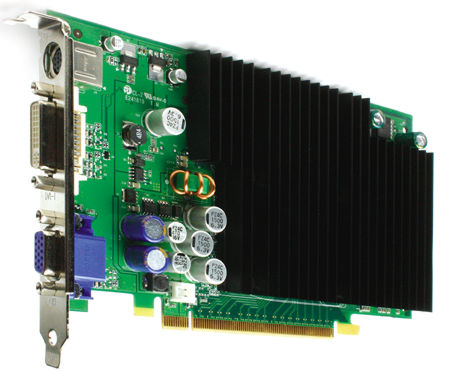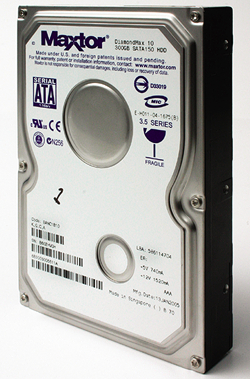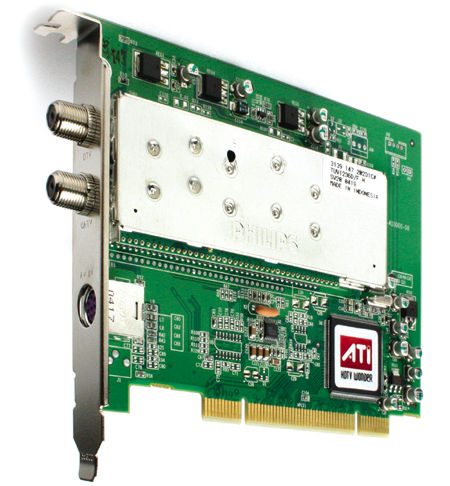HT's HTPC, Part II
I must admit, onboard video and audio have come a long way. It used to be that they were just a line item on a features list. Now both are far more capable. Compared with what you can get as a separate card, though. . .well, let's say it's not worth comparing (although I did, of course).

A separate board allows the manufacturer significantly more space to fill with RAM, chips, and so forth. In the case of a video card, this means more video RAM separate from your system RAM that you can use to play the latest games or run full-screen Windows Media Video HD at 1080p without a hiccup. While the onboard chip from Intel did 1080p just fine, it couldn't scale a DVD to 720p to save its life. It was unwatchable.
Asking a computer guy whether he's an NVIDIA guy or an ATI guy is like asking a car guy if he prefers Ford or Chevy. I've owned both (currently an ATI), but NVIDIA makes a silent, high-powered video card. So it was an easy choice. ATI makes an HD tuner card, so that was also an easy choice.
NVIDIA GeForce 6600 Passive
It's ironic (or perhaps expected) that the company that has been ridiculed for their massive (and necessary) cooling systems on previous models would be able to come out with a fast card with no fans. As you can see in the pictures, the GeForce 6600 Passive comes with just a big heat sink for cooling. You don't get more silent than that. To give you an idea of the GeForce 6600 Passive's processing performance compared with the onboard video, I used the industry semi-standard 3dMark05 from Futuremark. This test program plays several demos as part of a larger suite and gives you an overall numerical rating that you can compare with other setups, video cards, and so on. The onboard video measured a pitiful 276. The GeForce 6600 Passive measured a much beefier 2,072. The top-of-the-line video cards that are currently available will score significantly higher, but they aren't silent, are they? And that's the point. At home theater resolutions (i.e., 1,280 by 720), games like Doom 3 and Far Cry run smoothly with just about every option maxed. More importantly, NVIDIA has designed their drivers with home theater in mind. The scaling and deinterlacing problems that were such an issue with the onboard card are nonexistent here. While they aren't available with every card based on NVIDIA chips, the drivers that come with this decoder are wildly better. To be honest, the image from a DVD was the best I've seen off of a computer (which isn't saying much) and was just shy of the best-scaling DVD players (which is).
 ATI HDTV Wonder
ATI HDTV Wonder
I wish I had room to talk more about this product. If you're a do-it-yourselfer who doesn't have a TiVo, this thing is great. It does a great job of pulling in HD channels, even with just the included antenna. From there, you can record, pause, and store HDTV. The Man doesn't want you to be able to do this, so you can't buy this product from ATI anymore (although you can from other sources). The included RF remote works pretty well, but you'd be better off getting a wireless mouse/keyboard combo.
SoundBlaster Audigy 4
One word: DVD-Audio. Is that one word? What home theater is complete without high-resolution music. Granted, it adds three more cables to run from the back of your PC (three stereo pairs, actually), but it's worth it. DVD-Audio sounds great. It certainly doesn't sound as good as the best standalone players, but it's a lot better than CD. Surround sound in games also sounds great. I couldn't get a Dolby Digital 5.1 signal to appear at the digital output at all. But, if you've run the analog for DVD-Audio, then the digital isn't absolutely necessary. (Dolby Digital and DTS are decoded to analog.)
Storage
If you plan on ripping your DVDs to a hard drive (which is convenient, quieter during playback, and not at all what Hollywood wants you to do), or if you want to use your computer as an HD PVR, then you'll need lots of storage space. Our 480-gigabyte RAID array with dueling 300-GB Maxtor DiamondMax 10 drives is a good start. You can control it using software on Windows XP Pro or get a separate RAID controller, which may be even faster. RAID 0 arrays make for extremely fast write and re-write times but require two or more identical drives.

Software
I couldn't possibly begin to cover all the pieces of software available to turn your HTPC into the powerhouse of your dreams. There are a number of "front ends," or applications that run under Windows as an interface to your content. Microsoft has created Windows Media Center Edition (MCE) to do this very thing. MCE isn't perfect, but it's getting better. Check out www.pricewatch.com (another excellent resource) for places you can buy MCE. (You won't find it at your local Best Buy.) Meedio (www.meedio.com) makes a pretty slick front end that's close to Windows Media Center and is a lot cheaper. Both will take some time to set up, but all of your content will be available in one place with a (mostly) easy-to-use interface. It takes a lot of programming resources to make a front end work correctly, so, if you find one that's free, chances are it won't work as well as one that you have to pay for. NVIDIA is also working on an MCE-like front end. I used an early beta, and it's coming along quite well.
You'll also need to download the usual suspects for video and audio playback: Windows Media Player, DivX player, and WinAmp. All are free and work nicely.
Lastly, a Google search for "silent PC" will yield a number of good resources for quiet parts.
The Sound and the Fury
I wasn't happy with my HTPC's level of cooling, at least over longer "on" times. So I added a 120-millimeter exhaust fan. The larger the fan, generally, the quieter it is. This one added about 2 to 3 decibels to the quieter side of the case at idle. More importantly, by not requiring the main CPU fan to work as hard, it reduced the overall noise output after an hour of hard running by about 15 to 18 dB. There's a no-brainer of a tradeoff.

To further reduce the sound level, I added two pieces of foam to the edges of the "muffler" section and wrapped the center of the muffler in thick felt. Some people would have sewn this piece of felt together to hold it in place. I used a stapler. This, as you can imagine, didn't work. Most people would have then moved on to a different method of securing. Not me; I got a bigger stapler. The end result was about a 2-dB decrease in sound. Not bad. I was expecting none. Could it be quieter? Sure, and I'll keep trying. In the meantime, it is livable.
Pointers
If you've never built a computer from scratch, this isn't the place to start. Building a computer isn't hard, but the first one will require a fair amount of trial and error. Building a homemade case adds a lot of other issues. Don't go for cheap parts, either, as it can come back to bite you. Buy the fastest RAM you can afford, and get at least 1 GB of it. Trust me. The best advice I ever got on building computers was from my father, who always said, "Don't do plumbing on Sunday." That is, you're going to mess up, need a part, and the store won't be open. This creates nothing but frustration (again, trust me). It's ironic that building your own computer is almost always more expensive than buying one already built. But, if that mattered to you, you would never have read this article. If you have built some kind of case for your own silent HTPC, send me some pics at htletters@primedia.com. I'd love to see them.
Equipment list:
Intel D915GMH BTX Motherboard
Intel 3.6 GHz Pentium 4 Processor
Soundblaster Audigy 4 Sound Card
Kingston KVR400X64C3AK2 512-MB (2) RAM
Maxtor DiamondMax 10 300GB (2)
TDK Indi 1280B 12x+/8x- Multiformat DVD Burner
NVIDIA GeForce 6600 Passive
ATI HDTV Wonder ATSC/NTSC Tuner Card
- Log in or register to post comments




















































